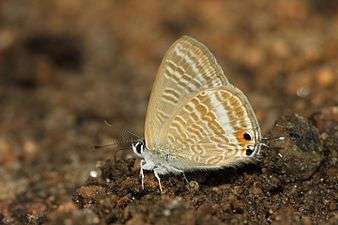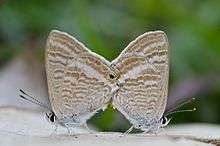Lampides boeticus
| Long-tailed pea-blue | |
|---|---|
 | |
| Lampides boeticus. Underside | |
| | |
| Lampides boeticus. Male. Upperside | |
| Scientific classification | |
| Kingdom: | Animalia |
| Phylum: | Arthropoda |
| Class: | Insecta |
| Order: | Lepidoptera |
| Family: | Lycaenidae |
| Genus: | Lampides |
| Species: | L. boeticus |
| Binomial name | |
| Lampides boeticus (Linnaeus, 1767) | |
| Synonyms[1] | |
|
List
| |
Lampides boeticus, the peablue, pea blue, or long-tailed blue, is a small butterfly that belongs to the lycaenids or gossamer-winged family.
Etymology
The Latin species name boeticus refers to Baetica, a province of the Roman Empire in the Iberian Peninsula .
Distribution
This species can be found in Europe, Africa, South and Southeast Asia, and Australia [2]
Habitat
This species inhabits the edge of forests, mountain meadows and hot flowery places at an elevation up to 2,700 metres (8,900 ft) above sea level. [3][4][5]
Description
The wingspan is 24–32 mm for males and 24–34 mm for females. [4] In these small butterflies the males have a mainly blue violet upperface of the wings with the brown edges, while the females have only a small amount of blue colour in the centre of the wings (sexual dimorphism). [6][7] Both sexes have a thin, long tail in the hindwings and two black spots in the anal angle.The underface of the wings is ocher and adorned with white markings and with a larger white submarginal streak. [5] The underface of each hindwing shows a pair of small black eye-spots beside each tail, with an orange marginal spots at the anal angle. [6]
This species is rather similar and it can be confused with Leptotes pirithous and Cacyreus marshalli.
Ecology
This species may have three generations a year. Adults fly from February to early November and are strong migrants. [4][5] Eggs are white with a greenish tinge and have a disc-shaped form. They can reach a diameter of 0.5 mm. They are laid singly on the flower buds of the host plants. [6]
Old caterpillars are green or reddish-brown, with dark dorsal stripe. They reach a length of 14-15 mm. Pupae reach a length of 9-10 mm. They are light grayish-brown with medium-sized dark spots and dark dorsal stripe. [3]
The larvae feed on flowers, seeds and pods of many Fabaceae species, including Medicago, Crotalaria, Polygala, Sutherlandia, Dolichos, Cytisus, Spartium and Lathyrus species. [2][8] It has also been recorded on Crotolaria pallida.[9]
In Australia, the larvae are occasionally attended by ants in the genera Froggattella, Iridomyrmex or Camponotus.[10]
See also
- List of butterflies of Australia
- List of butterflies of India
- List of butterflies of India (Lycaenidae)
- List of butterflies of Menorca
Bibliography
- Evans, W.H. (1932). The Identification of Indian Butterflies (2nd ed.). Mumbai, India: Bombay Natural History Society.
- Gaonkar, Harish (1996). Butterflies of the Western Ghats, India (including Sri Lanka) - A Biodiversity Assessment of a Threatened Mountain System. Bangalore, India: Centre for Ecological Sciences.
- Haribal, Meena (1992). The Butterflies of Sikkim Himalaya and Their Natural History. Gangtok, Sikkim, India: Sikkim Nature Conservation Foundation.
- Kunte, Krushnamegh (2000). Butterflies of Peninsular India. India, A Lifescape. Hyderabad, India: Universities Press. ISBN 978-8173713545.
- Gay, Thomas; Kehimkar, Isaac David; Punetha, Jagdish Chandra (1992). Common Butterflies of India. Nature Guides. Bombay, India: World Wide Fund for Nature-India by Oxford University Press. ISBN 978-0195631647.
- Wynter-Blyth, Mark Alexander (1957). Butterflies of the Indian Region. Bombay, India: Bombay Natural History Society. ISBN 978-8170192329.
- Tom Tolman et Richard Lewington, Guide des papillons d'Europe et d'Afrique du Nord, Delachaux et Niestlé, 1997 (ISBN 978-2-603-01649-7)
External links
| Wikimedia Commons has media related to Lampides boeticus. |
- Paolo Mazzei, Daniel Morel, Raniero Panfili Moths and Butterflies of Europe and North Africa
- Lepiforum.de
References
- ↑ Yutaka Inayoshi Butterflies in Indo-China
- 1 2 Funet
- 1 2 Lepidoptera Caucasi
- 1 2 3 Simon Coombes Captain's European Butterfly Guide
- 1 2 3 Euro Butterflies by Matt Rowlings
- 1 2 3 Lepidoptera Butterfly House
- ↑ New Zealand Butterflies
- ↑ Woodhall, Steve (2005). Field Guide to Butterflies of South Africa. Cape Town, South Africa: Struik. ISBN 978-1-86872-724-7.
- ↑ Kunte, K. 2006. Additions to the known larval host plants of Indian butterflies. Journal of the Bombay Natural History Society 103(1):119-121
- ↑ Braby, Michael F. (2004). The Complete Field Guide to Butterflies of Australia. CSIRO Publishing. ISBN 0643090274.



